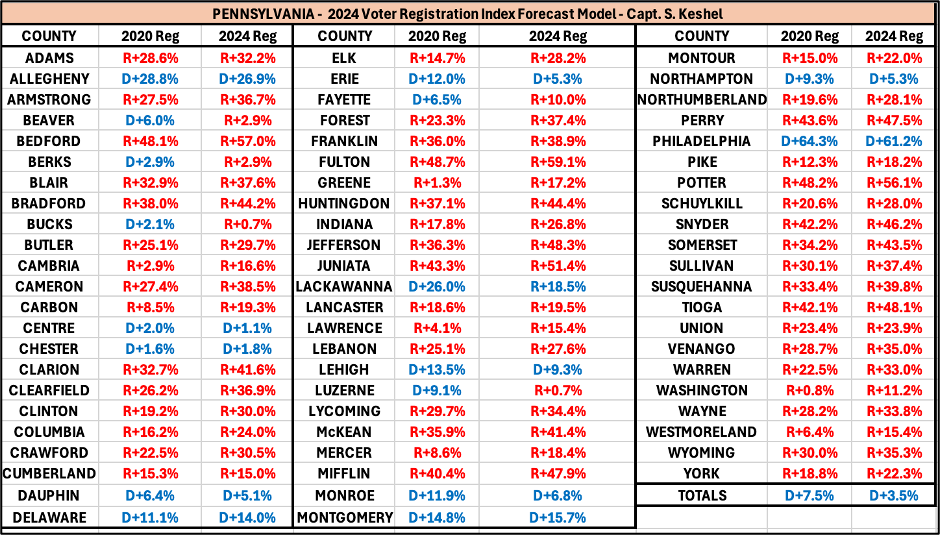Michigan - Trump v. Harris Voter Registration Index Forecast Model
Topic: 2024 Election Forecast
A lead-in on Voter Registration by Party analysis, from my Voter Registration Index Forecast Model preview of Arizona:
Voter Registration by Party is the most accurate of all indicators in assessing the trajectory of upcoming presidential elections in a county or state. The logic goes like this: if a young black man registers to vote as a Democrat in Philadelphia in August 2008, who do you think he is voting for? If a white, non-college factory worker from Johnstown, Pennsylvania, switches from Democrat to Republican in September 2016, who do you think he is voting for? If you chose Barack Obama and Donald Trump, respectively, your thinking is correct.
Critics of this theory like to say, “you don’t have to vote Republican just because you’re a Republican,” and to some extent, that is correct. It takes a little discernment to understand each county and its intricacies. Please read my pieces on Westmoreland County, Pennsylvania, and last week’s introduction to the 2024 Voter Registration Index Forecast Model, featuring Pinal County, Arizona.
Michigan has the potential to be a very tough state for Trump to win, but mainly because of the electoral engineering capabilities and the fact that more of the population is registered to vote than is age-eligible to vote, not because of the organic political climate that greatly favors the former president. Such estimates from states not registering voters by party must be inferred from states that do have it, like when I used Duval County, Florida, to predict how Georgia likely aligns this year, or when I used Iowa to peg Wisconsin. Trump is almost certain to have already won Pennsylvania and Wisconsin if Michigan comes into view, and likely enough decisive electoral votes to push him over 270 without the Great Lakes State, but its 15 electoral votes provide a welcome buffer to stave off a close race.
Along with Georgia, Michigan is easily in the top two grouping of most corrupt decisive states this year. It has a very large white working-class population that should greatly bolster Trump next month, and many minority groups, like Arabs and blacks, that are likely to be weaker for Harris than they have for any Democrat nominee since the 1980s, when all three Republican presidential campaigns carried the state by comfortable margins.
This piece focuses on likely outcomes based on registration analysis by county using Pennsylvania, and Trump’s own registration to results coefficient there. Michigan shares many overlapping demographics with the Keystone State, especially with regard to the vast swaths of each state populated by white working-class voters disparately impacted by the political establishment’s “America Last” trade arrangements, like NAFTA. Michigan has sat left of Pennsylvania for the past three decades thanks to Detroit’s collar counties dishing out more damage to GOP candidates than Philadelphia’s have. I will issue a formal projection blending all analytical disciplines right before Election Day which will consider any updates or developments regarding early voting data.
Pennsylvania Voter Registration by Party
I posted the status of Pennsylvania voter registration by party last night, showing the change from 2020 in all 67 counties, showing 63 shifted to the Republican right since the 2020 election:
Here is a readout since 2000 on how Pennsylvania’s results line up with the voter registration index:
Pennsylvania has been on a Republican shift for more than a decade following Obama’s 2008 high point, which marked the biggest landslide in the state since Lyndon Johnson’s 1964 victory. Romney, in a losing effort, benefitted from a decline in Democrat membership by cutting the results margin there roughly in half. Once Trump came on the scene, people began registering for the GOP and not simply falling off Democrat rolls, and this compounded things, culminating in a Trump flip in 2016. Trump narrowly “lost” Pennsylvania four years ago in a fortified election against an Irish Catholic who grew up in Scranton, but still finished 605,263 votes to the right of a +685,818 Democrat registration advantage. That has plummeted by more than 50% with still a week remaining for voter registration in the Commonwealth, making it seemingly impossible for Harris to hold this critical state. I will detail Pennsylvania county by county in my final voter registration forecast piece.
Analysis
If Trump runs right of the Democrat voter registration advantage in Pennsylvania by his average of 782,915, he will win the state by nearly a half-million votes, close to 7%. I think that is overly bullish because the severity of rapidly reclassifying party registrations begins to lessen as a state realigns itself. Taking the GOP average since 2000, which balances out thanks to a few extreme samples, we still find a result 620,635 right of the registration advantage, nearly identical to the differential Trump was limited to in 2020 thanks to the conduct of that quasi-election.
Keep reading with a 7-day free trial
Subscribe to Captain K's Corner to keep reading this post and get 7 days of free access to the full post archives.





